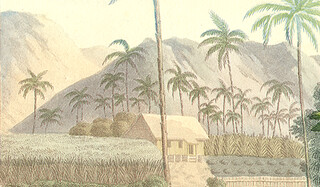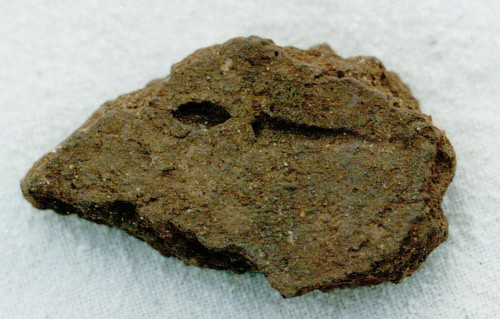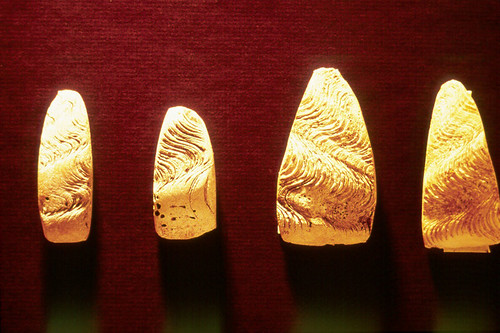View more images for the Ancient CHamoru Agricultural Practices entry here.
Ancient CHamoru horticulture
For most people in the Marianas today, getting something to eat is as easy as a trip to the grocery store or to a favorite restaurant. This is different from a century or even a few decades ago, when many families had their own ranches where they grew vegetables or fruit, or raised animals for their families to eat.
Because few of us actually grow our own food, it is easy to take for granted the abundance of food around us. Most people don’t know how food actually gets from farms to food processing places, and finally, to the local grocery store and the dinner table. But actually, food collecting is one of the most important activities in order for a population to survive.
Food nourishes us—without food we cannot perform other functions of life. Additionally, the kinds of food available often depend on the environment and climate, which, in turn, can affect population size and social complexity—like the type of economy or political system a society has.
Some foods are also given social, political or cultural meanings, and become important parts of traditions and customs. Can you imagine Thanksgiving without turkey, or a village fiesta without hineksa’ aga’ga’ (red rice)? We can learn a lot about a culture not only by the foods people eat, or by what occasions they use certain food items, but also by the way people collect, prepare or process, and even store food.
Archeologists are interested in how people of the past collected and used food. The earliest inhabitants of the Mariana Islands probably lived in small populations along the coastlines where they could easily gather food resources from the lagoons and reefs, or sail into open water for large fish. Plants, such as seeded breadfruit and coconut, were also abundant and easily obtainable.
Eventually, these islanders were able to cultivate food items that were not only native to the Marianas but other plants they brought with them from their ancient homelands in Southeast Asia, including seedless breadfruit, taro, bananas, sugar cane and rice. This shift from food collectors to food producers reflect other lifestyle changes for the ancient CHamorus.
Anthropologists describe three food production systems among different societies—horticulture, intensive agriculture, and pastoralism. Of the three, horticulture probably best describes ancient CHamoru society. Horticulture involves the growing of food plants and other crops using relatively simple tools and methods. This is different from intensive agriculture, which may involve making large changes in the natural landscape to accommodate fields for crops and the use of more complex irrigation systems or tools. Archeologists use evidence from excavations, radiocarbon dating and other records to paint a picture of how ancient people acquired and processed the foods they relied on for life.
Agriculture of the ancient CHamorus
According to Webster’s New Collegiate Dictionary, the term “agriculture” is defined as the science or art of cultivating the soil, producing crops, and raising livestock in order to feed or otherwise benefit a group of people.
When did the ancient people of Guam begin to cultivate the soil and grow crops? Some archeologists have proposed that the appearance of microscopic bits of charcoal in soils taken from wetland core samples on Guam is related to the initial arrival of people at least 3,500 years ago and provides evidence that they began clearing and burning (slash-and-burn).
Slash-and-Burn
A technique that involves the removal of trees or undergrowth by controlled burning, to clear a spot for planting.
If the charcoal in the cores is interpreted as an indication that people cleared and burned, then it could be inferred that they also planted. When and where planting took place remain open to conjecture as solid archeological evidence—such as agricultural features or farming related tools, which would have been used in clearing or planting activities—has yet to be identified at early archeological sites. Likewise, there is no compelling archeological or historical evidence to indicate that livestock, including pigs and chickens, were raised prior to European contact in AD 1521.
Due to the limited information about early farming activities and the probable absence of livestock, this article describes what is known about the crops that were traditionally planted, harvested, and eaten during the Latte Period (AD 900-1521) and the early part of the Historic Period.
Information about the Latte Period’s traditional gardens derives from two kinds of sources:
- the early historic accounts written prior to 1602.
- the records and reports of investigations completed at archeological sites.
From these sources, inferences can be made about what plants were grown. A more detailed list of the island’s pre-contact vegetation can be compiled from the various studies of soils taken from wetland cores and archeological sites.
Details regarding the preparation and planting techniques used in Guam’s Latte Period garden plots are lacking. It is obvious that the vegetation had to be cleared or partially removed in order to open the rainforest canopy to allow enough sunlight to reach the new plants. Once cut, the vegetation could have been burned, or left to decay on the ground surface. Either method can return important nutrients to the soil.
The Latte Period gardening system probably involved multiple strategies involving fruit bearing trees as well as field crops. Both dry places and moist areas on the edges of wetlands and streams were likely utilized. One planting strategy may have involved shifting cultivation, a common pattern elsewhere in the Pacific. Under this system, garden plots are left fallow or unplanted for longer periods of time than they are cropped. Generally, a dry plot is left fallow after it yields one harvest. However, when root crops are followed by non-root crops, a dry plot can be used for a longer period of time.
Early historic accounts
Early historic accounts describe the CHamoru diet at European contact in 1521 as consisting of fish, rice, roots, breadfruit, coconut, ginger, bananas, and sugar cane. This food list lacks specific information about the kinds of root products that were consumed, but it is likely that taro, yams and the tubers of arrowroot (gapgap or gabgab, Tacca leontopetaloides) and perhaps Cordyline contributed to the traditional diet. Rodrique Lévesque’s translations of the early European reports indicate that the CHamorus traded with passing ships, exchanging products of their land for pieces of metal.
Most of the plants that made up the foods on the list above required human intervention to flourish, yet the early historic accounts lack descriptions of gardens and gardening practices. The first European observation of agricultural fields was made by the Miguel Legazpi expedition in 1565. Under orders to claim the Mariana Islands for Spain, his ships anchored off of Humåtak for 11 days. During their stay the visitors noted many rice fields, but they did not indicate if the rice was grown in paddy (wet) fields or dry fields.
The most detailed report of gardening practices and local foods was made by Fray Juan Pobre de Zamora, a lay brother of the Franciscan order of Discalced Friars, who jumped ship and lived on Rota for seven months in 1602. His observations were made prior to the establishment of a Spanish settlement in 1668, but well after the beginning, in 1565, of Spain’s Manila Galleon trade which involved stops at Guam. By the time of Pobre’s visit, the CHamorus were raising two other crops—sweet potatoes and corn—which the Spanish had introduced from the Americas. Although the Pobre information pertains to Rota, it can be inferred that similar practices took place on Guam.
Pobre states that the gardens were located in the jungle and in the hills some distance away from the coastal villages. The soil was worked with wooden sticks and every able-bodied person participated in the work. The women tilled and planted. Slaves were not used to farm, but Pobre noted that a type of servant, brought up by the family, did some of the farming.
The most common crops raised were two types of yam and two types of taro. Details of the actual planting or harvesting techniques of these root crops were not included. Although Pobre did not mention rice fields, he described foods containing rice, which indicates that the grain was available. Sometimes ground rice was mixed with grated coconut. Breadfruit, which had been either roasted or boiled, was eaten as well. It is clear from the Pobre account that rice, root crops, breadfruit trees, coconut palms and probably other fruit trees made up the traditional agricultural system.
Other evidence that CHamorus tended plants is provided by Francisco García’s compilation of the early missionary reports. The Jesuit priests, who established a Catholic mission on Guam in 1668, sometimes purchased food from the CHamorus. In 1676, for example, García noted a priest went to Upi in northern Guam to collect yams from a local resident. At other times, the Spanish soldiers confiscated stored food supplies, such as rice, when they burned the villages of defiant CHamorus.
In the 1680s when the Spanish moved the people into six population centers on Guam, the relocation was made with the understanding that the local people would retain access to their trees and gardens. It is not clear to what extent the forced resettlement (or reducción) disrupted traditional agricultural practices, but it is probably at least partly responsible for the land use pattern in effect until World War II. Generally, families had a village residence (where they attended church) and a ranch (låncho) located some distance away.
Archeological records
The various artifacts recovered from archeological sites, such as pottery sherds and large grinding stones (lusong), suggest something about the kind and range of activities that took place prior to European contact. For example, the Latte Period (AD 900-1521) pottery sherds suggest that foods were boiled or steamed in clay pots. Microscopic analyses of charred remains on some pottery sherds identified starch and other plant parts from taro (Colocasia), which suggests that taro was one of the foods commonly cooked. Yams (Dioscorea) are another food that may have been boiled in the pots. A radiocarbon date associated with yam thorns indicates these plants were present by AD 1000. Earlier evidence of yams is provided by a single yam pollen grain in a soil sample associated with a calibrated radiocarbon date with a range of AD 670-880.
Gardening Tool
The principal CHamoru gardening tool was a simple sharpened stick, fashioned from the wood of the betel palm. One end would be shaped into a knife-like tip, and the tool would be used to till the land, as well as remove weeds.
Accidental impressions of rice grains on other pottery sherds suggest that rice was present near the areas where the clay was gathered or the pots made. A radiocarbon date, associated with a rice impressed sherd from Tumon, Guam, indicates that rice was present by the mid-1300s, and there is some evidence that it was present earlier. Although rice starch has yet to be identified in the residue remaining on the sherds, it is likely that rice was prepared in some pots.
Precise dates for the advent of these various food plants to Guam remain unknown, but it is clear from the archeological evidence and soils analyses that coconut, taro, yam, rice, breadfruit, ti, sugarcane, and bananas were present during the Latte Period. These food plants would have been cultivated or tended by people.
The numerous bedrock and emplaced stone mortars, also known as lusong, found at Latte Period sites across the island are thought to have been used to husk the rice, grind foods, and prepare medicinal plants. Latte Period stone and shell cutting tools could have been used to clear the gardens, harvest the rice, and peel and section tubers and other foods, while other implements such as a wooden pestle, called fa’lu, would have been used with lusong to husk the rice.
There are few descriptions of prehistoric agricultural features in the landscape on Guam. Terraces, irrigation canals, or other agricultural earth works are uncommon in site reports. The exception is a probable planting zone identified in the Manenggon Hills project area in southern Guam. The 2.5 m long (North/South) zone was exposed in the face of a new road that cut through a low rise. The zone included the profiles of three pits with an area of disturbed soils to the north. Pits 1 and 3 were basin shaped while Pit 2 had a “V” shape. Charred coconut shell, yam thorns, and a few pieces of intrusive coralline rock were recovered from Pits 1 and 3, and a Latte Period pottery rim was recovered from Pit 2. A sample of the coconut shell from Pit 1 showed a radiocarbon date range of AD 986-1210.
Seasons
Historian Scott Russell points out that the ancient CHamorus understood that seasonal periods of drought and rain (uchan), as well as natural disasters could significantly affect the production—and consumption—of certain kinds of food resources. This knowledge is reflected in the traditional CHamoru calendar, which divides each year (sakan) into thirteen periods (pulan), with their associated weather conditions and subsistence activities.
Pits 1 and 3 were interpreted as yam planting/harvesting pits, possibly situated in a dry garden plot. It was proposed that the coconut shell and the coralline rock had been purposefully added by the Latte Period farmers to increase the fertility of the soil. A treatment to improve similar soils on Guam was recommended by soil scientist Fred Young in 1983. He pointed out that the addition of compost could boost fertility and crushed coral limestone could provide calcium and reduce the soil’s acidity.
The intact profiles of the three pits suggest that the apparent plot was used for a short time before being abandoned. While this zone may be the earliest recognized farming site on Guam, it was probably not the first attempt to cultivate this part of the island. The apparent soil modification techniques suggest that the planters had gained experience with similar soils and acted appropriately by adding elements to ensure planting success.
Rice may have been another crop grown in the Manenggon Hills project area. Sherds with rice impressions were recovered from several different sites. One sherd was associated with a radiocarbon date with a range of AD 1325-1491. Both dry land rice and paddy rice could have been grown in the project area, but archeological evidence of rice fields was not recognized.
Dating the beginning of cultivation in the island’s interior was not possible with the Manenggon Hills data, however the radiocarbon dates from the project area indicate that it was used more often after AD 1000. Based on the temporal distribution of the dates, Rosalind Hunter-Anderson and Darlene Moore proposed that use of this inland area increased beginning in the 1200s, continued through the 1400s, and decreased in the 1500s. The reasons for the expansion and retreat remain open to discussion, although it may have involved a combination of both climatic and social factors.
For further reading
Athens, J. Stephen, and Jerome V. Ward. “Holocene Vegetation, Savanna Origins and Human Settlement of Guam.” Records of the Australian Museum, Supplement 29, no. 1 (2004): 15-30.
Athens, J. Stephen, Michael F. Dega, and Jerome V. Ward. “Austronesian Colonisation of the Mariana Islands: The Palaeoenvironmental Evidence.” Bulletin of the Indo-Pacific Prehistory Association 24, (2004): 21-30.
Carson, Mike T., ed. “Archaeological Studies of the Latte Period.” Micronesica 42, nos. 1-2 (2012).
Driver, Marjorie G. The Account of Fray Juan Pobre’s Residence in the Marianas, 1602. MARC Miscellaneous Series No. 8. Mangilao: Micronesian Area Research Center, University of Guam, 1993.
García, Francisco. The Life and Martyrdom of Diego Luis de San Vitores, S.J. Translated by Margaret M. Higgins. Mangilao and Hagåtña: Micronesian Area Research Center, University of Guam, and Nieves M. Flores Memorial Library, 1985.
Guam Historic Preservation Trust. A Paleoenvironmental Investigation of the Effects of Prehistoric Chamorro Farming Practices on the Native Vegetation in Southern Guam. By Rosaline L. Hunter-Anderson. Hagåtña: GPT, 1994.
Hunter-Anderson, Rosalind L. “Savanna Anthropogenesis in the Mariana Islands, Micronesia: Re-interpreting the Palaeoenvironmental Data.” Archaeology in Oceania 44, no. 3 (2009): 125-141.
Hunter-Anderson, Rosalind L., and Darlene R. Moore. “Retreat or Expansion: Tracking Prehistoric Settlement in Guam’s Interior.” Paper presented at the Australian Archaeological Association Meetings, La Trobe University, Victoria, Australia, 24-26 November 1994.
Hunter-Anderson, Rosalind L., Gillian B. Thompson, and Darlene R. Moore. “Rice as a Prehistoric Valuable in the Mariana Islands, Micronesia.” Asian Perspectives 34, no. 1 (Spring 1995): 69-89.
Lévesque, Rodrigue. History of Micronesia: A Collection of Source Documents. Vol. 2, Prelude to Conquest. Québec: Lévesque Publications, 1992.
MDI Guam Corporation. Archaeology in Manenggon Hills, Yona, Guam. Vols. I-IV. Edited by Rosalind L. Hunter-Anderson. Mangilao: MARS, 1994.
Moore, Darlene R. “Archaeological Evidence of a Prehistoric Farming Technique on Guam.” Micronesica 38, no. 1 (2005): 93-120.
US Department of Agriculture Soil Conservation Service. A Soil Survey of the Territory of Guam. By Fred J. Young. Washington, DC: NRCS, 1988.




